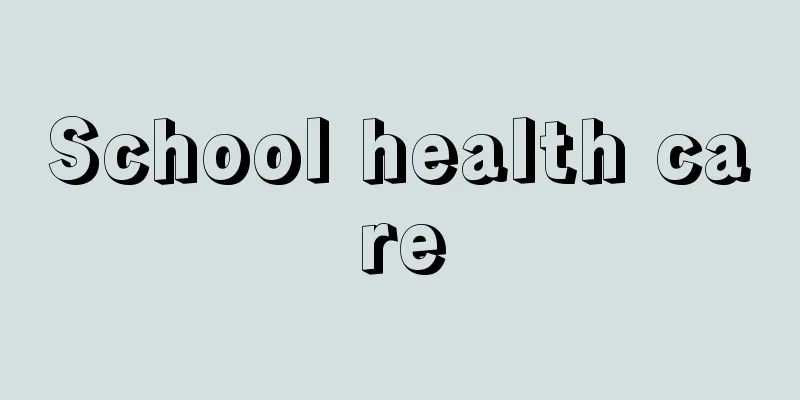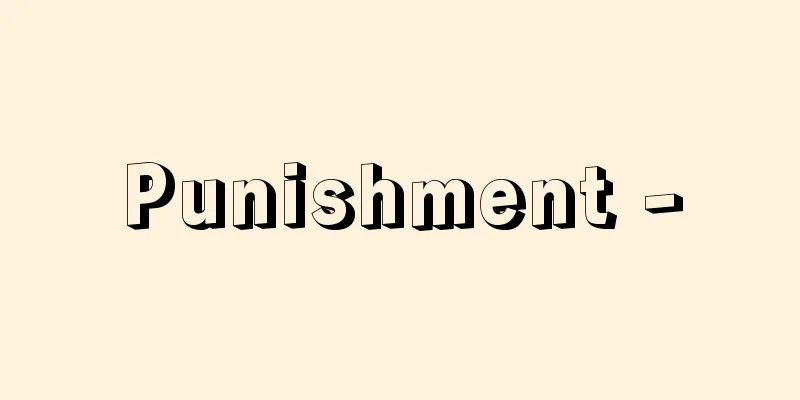School health care

|
It is a general term that encompasses management, guidance, and learning aimed at maintaining and promoting both the physical and mental health of children, students, and teaching staff. As stated in Article 1 of the Fundamental Law of Education (Purpose of Education), the physical and mental health of children and students is positioned as a fundamental educational goal. Therefore, school health can be said to be an educational activity that is clearly institutionalized by law as part of school education. At the same time, it is an educational function that is essential for establishing healthy lives for children and students now and in the future. [Kazuomi Kamuro] Development process in JapanIn 1897 (Meiji 30), the School Cleanliness Act and Regulations for Physical Examination of Students were enacted, and the following year in 1898, the School Doctor Ordinance was enacted, appointing school doctors to public schools. During the Meiji period, the German system was used as a model, with school doctors playing a central role in managing any impediments or disabilities associated with educational activities from a medical and hygienic perspective. This period is known as the "era of medical school hygiene." After that, there was an "institutional vacuum (1903-15)," but from 1916 (Taisho 5), the system expanded, with prefectures assigning school hygiene technicians, and so on. The Taisho period was modeled on the British system, and was known as the "era of social school hygiene," as schools' medical facilities, school nurses, and school lunches became widespread. American health education was introduced in 1926 (Taisho 15), and the role of educators in school hygiene began to be emphasized. This period is called the "era of educational school hygiene." The period from 1937 (Showa 12) to 1945 (Showa 20) is called the "wartime school hygiene era," and during this period, in 1941, the National School Act was enacted to institutionalize health care training. After World War II, the report of the first American educational mission pointed out the promotion of health education and the improvement of health management, including health checkups. After that, the health field (subject) was established as a subject of education, and the system of school health was improved. The name was also changed from the prewar "school hygiene" to "school health." In 1958, the "School Health Act" was enacted, and the health management system was established. Furthermore, in 2009, the School Health Act was renamed the School Health and Safety Act, which established provisions for the strengthening of systematic health guidance centered on school nurses, cooperation with local medical institutions, and the legalization of environmental hygiene standards in schools, as well as newly stipulating matters related to school safety. [Kazuomi Kamuro] School health organization and functionsAlthough the composition of school health organizations varies depending on the actual conditions of the school and the school management policy, they generally consist of the principal, vice principal, health chief (health officer), school nurse, teachers, school doctor, school dentist, school pharmacist, etc. In order for the activities of these organizations to be more functional, a common understanding and cooperative relationships among the school's teaching staff are essential. Within this, the core of school health promotion are the health chief and the school nurse. In particular, the school nurse is directly responsible for the management of the health room and is responsible for the practical aspects of health management and guidance. [Kazuomi Kamuro] School HealthThe conventional wisdom is that health management is broadly divided into two areas: health care and health service, which are service activities aimed at maintaining and promoting health, and health education, which is an educational activity aimed at cultivating the ability to maintain a healthy lifestyle. In contrast, there is a view that it is composed of three areas: health management, health learning (health teaching), and health guidance. The former is considered to be a teleological view of school health, while the latter is considered to be a domain-functional view. Currently, the latter, domain-functional view of school health, is the conventional wisdom. From the perspective of school management, this can be thought of as follows: health management is management = management process (school management), health learning (teaching) is a learning process (subject instruction -- physical education in the upper grades of elementary school, the health field of health and physical education in junior high school, and health subjects in health and physical education in high school), and health guidance = life formation process (life guidance), and these positions are based on legal grounds and standards. [Kazuomi Kamuro] Health ManagementThe contents of this area are subject management, environmental management, and lifestyle management, and they are mainly regulated by the School Health and Safety Law. When the law was enacted in 1958, the diseases with high incidence rates among children and students were infectious diseases caused by poor environmental hygiene, such as parasitic infections, enlarged tonsils, trachoma, and infectious skin diseases. However, the incidence has gradually decreased due to improvements in environmental hygiene, thorough health guidance, and improved living standards. However, with the rapid changes in living environments, so-called chronic diseases such as kidney disease, heart disease, and asthma, which were not seen much in children and students until now, are increasing year by year and are now being raised as new school diseases. Currently, the three major school diseases are kidney diseases such as nephritis and nephrosis, congenital and rheumatic heart disease, and bronchial asthma. Kidney disease in particular was previously thought of as an adult disease, but it has now come to occupy the top of the three major school diseases. In light of this situation, the Enforcement Order and Enforcement Regulations of the School Health Act were revised in May 1973, making it mandatory to include urine tests and heart examinations in school health checkups. This promoted early detection and early treatment measures in the aspects of self-management and lifestyle management in school health. Furthermore, in September 1978, the Enforcement Regulations of the School Health Act were partially revised, and the minimum guidelines for urine tests were set out as follows: "Urine" tests will be added as a required item to the test items in health checkups for children and students. Urine tests should be performed using test strips to check for protein, etc. It is desirable to also perform an occult blood test to detect kidney disease. Urine tests should be performed annually. [Kazuomi Kamuro] Health EducationThe contents of this area are health studies and health guidance, which are stipulated in the Enforcement Regulations of the School Education Act and are divided into health studies (instruction) through subjects based on the curriculum guidelines, and health guidance through special activities. [Kazuomi Kamuro] History and current situation of each countryIn the UK, health education in schools has a long history, and the Ministry of Education has issued guidelines. However, there is no consensus on the time and methods for implementing health education that utilizes these guidelines. In France, health education is implemented in all subjects in primary education, and in secondary education, health education content is included in related subjects such as science, social studies, civics, physical education, and home economics, and safety education is a mandatory requirement. In Russia, there is a strong interest in health education, and since the 1953 All-Soviet Conference on School Health, systematic health and hygiene education has been incorporated into natural science subjects and even into Japanese language subjects. [Kazuomi Kamuro] New school health activitiesIn 1988, the Ministry of Education merged the School Health Section and School Lunch Section, which had been organized within the Physical Education Bureau, to form a new organization called the School Health Education Section. Previously, school health in the broad sense had been a comprehensive activity covering areas such as physical education, school safety, and school lunches, as well as issues related to the health and safety of children and students, but this change in the central administrative structure is thought to have further enhanced the comprehensiveness of school health, which is at the intersection of health and education. In addition, following the reorganization of government ministries and agencies in 2001, when the Ministry of Education and the Science and Technology Agency were merged to form the Ministry of Education, Culture, Sports, Science and Technology, the Physical Education Bureau was reorganized into the Sports and Youth Bureau, and the School Health Education Section became an organization of the same bureau. [Kazuomi Kamuro] School CounselorSince the 1990s, a wide range of problems affecting children and students have become more complex and apparent, including school bullying, school refusal (truancy), maladjustment in groups, class breakdown, delinquent tendencies, neurotic tendencies, poor academic performance, and problems related to the home life of children and students. In light of this reality, there have been calls for the need for and enhancement of counseling in schools, and the placement of counselors as specialists has come to be considered. In this section, I will discuss the need to improve and enhance counseling functions in the field of school health and to make them effective in order to address the "health problems" of children and students from both the mental and physical perspectives. In schools, they are generally placed as educational counselors in the student guidance department (or life guidance department), but it seems that there are not many schools that provide counseling in a planned and organized manner and that are effective. On the other hand, as the term "attending the school nurse's office" indicates, children and students attend school in the nurse's office instead of in their classrooms, and the school nurse responds to them. In addition, while there is a demand for full-time school counselors to play a central role in promoting and managing the mental health of children and students, it is also true that there are voices of opposition to the placement of specialists. There is a strong opinion among teachers that it is more important for all teachers to have a counseling mind and interact with and guide the children and students of their own schools, rather than how much effect can be expected from one counselor per school. In any case, it is necessary to explore what functions schools should have to maintain and promote the "mental health" of children and students, and to take action to establish such functions as soon as possible. Regarding the role of school counselors, there is constant debate as to whether they should emphasize therapeutic counseling or developmental counseling, but in Japan, for the time being, the role of counselors is expected to be to treat children and students with problematic behavior that cannot be handled by their homeroom teacher or other teachers. In the future, in order to gain understanding and support for the need for developmental and preventive counseling in Japanese schools, we hope that a practical theorization of school counseling unique to Japan, based on the practice of school counselors, will be created within schools. [Kazuomi Kamuro] "Collection of Theory and Practical Cases of School Educational Counseling" edited by Eiji Koizumi and Tetsuo Takahashi (1986, Daiichi Hoki Publishing)" ▽ "Basic Issues in School Counseling" by Yasutaka Kokubu (1987, Seishin Shobo)" ▽ "Outline of School Health" by Masahiro Takaishi (1988, Dobun Shoin)" ▽ "New School Health" revised and expanded edition by Masateru Sugiura and Isao Narita, with Shigeharu Ieda, Hideo Imai, Fukuji Kamienobu, Taku Kondo, Mitsuaki Shibakawa, Shintaro Tanabe and Tadahiro Nohara (1996, Kenpakusha)" ▽ "The 80-Year History of the Japan School Health Association" edited and published by the Japan School Health Association (2005)" ▽ "A School Health Manual Based on the Perspective of Development" edited by Yoshikatsu Eto and edited by Takuhiro Tahara (2005, Shindan to Chiryousha)" ▽ "An Introduction to School Health," edited by Matsuoka Hiroshi (2005, Koseikan)" ▽ "School Doctor and School Health Handbook -- All the Necessary Knowledge and Perspectives," edited by Eto Takashi and Nakahara Toshitaka (2006, Bunkodo)" ▽ "School Health and Safety Practice Research Group, edited, School Health Practice Essentials, revised edition (2006, Daiichi Hoki Publishing)" ▽ "Learning School Health from the Basics," edited by Takizawa Toshiyuki (2008, Kenpakusha)" ▽ "School Health Manual, revised 7th edition, by Takaishi Masahiro and Idei Michiko (2008, Nanzando)" ▽ "Health Promotion and School Health -- Toward the Improvement and Strengthening of Health Education," by Uchiyama Gen (2009, Kasei Kyoikusha) [Reference items] | | | | | |Source: Shogakukan Encyclopedia Nipponica About Encyclopedia Nipponica Information | Legend |
|
児童・生徒ならびに教職員の心身両面にわたる健康の保持増進を図るための、管理・指導・学習を包括する総称である。 教育基本法第1条(教育の目的)に明記されているように、児童・生徒の心身の健康は、教育の基本的な到達目標として位置づけられている。したがって、学校保健は、学校教育の一環として法的にも明確に制度化されている教育活動であるといえる。同時に、児童・生徒の現在および将来における健康生活の確立に不可欠な教育作用である。 [加室一臣] 日本における発展過程1897年(明治30)に「学校清潔法」「学生生徒身体検査規定」、翌1898年に公立学校に学校医を置く「学校医令」が定められた。明治期はドイツの制度を模範として、学校医が中心となって、教育活動に伴う支障や障害を医学的・衛生学的観点から管理することにあった。この時代を「医学的学校衛生の時代」という。その後「制度的な空白時代(1903~15)」を経て、1916年(大正5)以降は、道府県に学校衛生技師を置くなど制度的拡大がみられた。大正期はイギリスの制度を範として、学校内診療施設、学校看護婦、学校給食などが普及したので「社会的学校衛生時代」という。 1926年(大正15)からアメリカの健康教育が導入され、学校衛生における教育者の役割が重視されるようになった。この時代を「教育的学校衛生の時代」という。1937年(昭和12)から1945年(昭和20)までを「戦時下の学校衛生時代」といい、この間の1941年に国民学校令によって養護訓練の制度化がなされた。第二次世界大戦後、第一次アメリカ教育使節団報告によって、保健教育の振興、健康診断をはじめ保健管理の充実などが指摘された。その後、教科教育としての保健分野(科目)が新設されるなど、学校保健の制度的な改善が行われた。名称も戦前の「学校衛生」から「学校保健」へと改称された。1958年に「学校保健法」が制定され、保健管理面の制度は整備された。また、2009年(平成21)には「学校保健法」が「学校保健安全法」に改称され、養護教諭を中心とした組織的な保健指導の充実、地域医療機関等との連携、学校の環境衛生基準の法制化等が定められるとともに、学校安全についての事項が新たに規定された。 [加室一臣] 学校保健組織と機能学校保健組織は、学校の実態や学校経営方針などによって構成上の差異はあるが、おおむね校長、教頭、保健主任(保健主事)、養護教諭、教諭、学校医、学校歯科医、学校薬剤師などをもって構成する。これらの組織の活動が、より機能的な活動となるためには、学校教職員の共通理解と、協力的な相互関係が必要条件である。そして、そのなかにあって学校保健推進の中核が保健主任、養護教諭である。とくに養護教諭は保健室の経営を直接担当し、保健管理・指導の実務にあたる。 [加室一臣] 学校保健の領域従来の通念では、健康を保持増進するためのサービス活動health care, health serviceとしての保健管理と、健康生活を維持できる能力を育てる教育活動としての保健教育health educationとの2分野に大別している。これに対して、保健管理・保健学習(保健教授)・保健指導の3分野で構成する考え方がある。前者は学校保健を目的論的に構成したものであり、後者は領域機能論的に構成したものと考えられる。現在は、後者の領域機能論的学校保健が通念となっている。 これを学校運営の視点からみると、次のように考えられる。保健管理は経営=管理過程(学校経営)、保健学習(教授)は学習過程(教科指導――小学校高学年では体育科、中学校では保健体育科の保健分野、高等学校では保健体育科の保健科目)、そして保健指導=生活形成過程(生活指導)とし、これらの位置づけは法的根拠や基準に基づいている。 [加室一臣] 保健管理この領域内容は主体管理、環境管理、生活管理であり、それらは主として学校保健安全法によって規定されている。制定当時(1958)の児童・生徒の罹患(りかん)率の高い疾病は、寄生虫感染、扁桃(へんとう)肥大、トラコーマ、伝染性の皮膚病など、環境衛生の不備による感染症であった。それが、環境衛生の改善、保健指導の徹底、生活水準の向上などによってしだいに減少してきた。 しかし一方、生活環境の急激な変化に伴って、いままで児童・生徒にあまりみられなかった腎臓(じんぞう)病、心臓病、喘息(ぜんそく)などの、いわゆる慢性疾患が年々増加し、新しい学校病として問題を投げかけるようになった。現在では、腎炎、ネフローゼなどの腎臓病、先天性やリウマチ性の心臓病、気管支喘息が三大学校病とされている。とくに腎臓病は従来成人の病気として考えられていたが、それが三大学校病のトップを占めるに至った。 このような実情から、1973年5月に学校保健法施行令、学校保健法施行規則が改正され、学校における健康診断に尿検査、心臓検診を加えることが義務づけられた。このことにより、学校保健における主体管理および生活管理面で、それらの早期発見、早期治療対策が促進されることになった。さらに1978年9月、学校保健法施行規則の一部が改正され、尿検査の最低ガイドラインが次のように示された。児童・生徒の健康診断の検査項目に、新たに「尿」検査を必須(ひっす)項目として加える。検尿は試験紙法によりタンパクなどについて行うこと。腎臓病発見のためには潜血検査をあわせ行うことが望ましい。検尿は毎年行うこととする。 [加室一臣] 保健教育この領域内容は保健学習と保健指導であり、それらは学校教育法施行規則に規定されていて、学習指導要領に基づく教科による保健学習(教授)と、特別活動による保健指導とに分けられる。 [加室一臣] 各国の歴史と現状イギリスでは、学校における健康教育は古い歴史をもち、文部当局から指導指針が出されている。しかし、その指針を生かした健康学習を実施する時間の位置づけや方法については、統一的見解をもつに至っていない。フランスでは、初等教育の全教科のなかで実施され、中等教育では、理科、社会科、公民科、体育科、家庭科などの関連教科に健康学習の内容が入れられていて、安全教育が必須化されているところに特徴がある。ロシアでは、健康教育に関心が深く、1953年学校保健に関する旧全ソ連邦会議以後は、体系的な保健・衛生学習が、自然科学教科や、さらに国語のなかでくふうされている。 [加室一臣] 新しい学校保健活動文部省は1988年(昭和63)に、体育局内に組織されていた学校保健課と学校給食課を合併して、新組織「学校健康教育課」を発足させた。従来から広義の学校保健として、体育・学校安全・学校給食などの領域から、児童・生徒の健康・安全に関する課題までを包括して活動してきたが、この中央行政機構の改変が学校保健のもつ総合性をますます高め、健康と教育の接点にある学校保健のいっそうの充実が図られたものと考えられる。なお、2001年(平成13)の省庁再編により文部省と科学技術庁が統合され文部科学省となったのに伴い、体育局はスポーツ・青少年局に改組され、学校健康教育課は同局の組織となった。 [加室一臣] スクールカウンセラー1990年代以降、学校におけるいじめ、登校拒否(不登校)、集団不適応、学級崩壊、非行傾向、神経症傾向、学業不振、児童・生徒の家庭生活に関する問題など、児童・生徒にかかわる広範な問題が複合化、顕在化している。このような現実から、学校におけるカウンセリング(相談)の必要とその充実が叫ばれ、その専門職としてのカウンセラー(相談担当者)の配置が考えられるようになった。児童・生徒の「健康問題」を心と身体の両面からとらえるために、学校保健の領域でもカウンセリング機能を整備・充実させ、それを作用させる必要を一つの問題提起として、この項でも述べてみる。 学校では、一般的に生徒指導部(または生活指導部)のなかに教育相談係として置かれているが、計画的、組織的に相談活動(カウンセリング)が行われ、その効果を高めている学校はそう多いとは思われない。だが、一方「保健室登校」ということばで表されるように、児童・生徒は教室ではなく保健室に登校して、一日の学校生活を終え、養護教諭がそれに対応している現実もある。また、児童・生徒の心の健康の増進、管理の中心的役割を担うスクールカウンセラーを専任として配置することは当然という要望がある反面、専門職の配置に反対の声があることも事実である。1校1人のカウンセラーにどれだけの効果が期待できるのか、それより教師全員がカウンセリング・マインドをもって、自校の児童・生徒との触れ合いや指導にかかわるほうがよりたいせつという意見が教師のなかに根強い。いずれにしても、学校がどのような機能をもてば、児童・生徒の「心の健康」を維持・増進させることができるかを模索し、早急にその整備を図り行動することが必要である。 スクールカウンセラーの役割について、治療的カウンセリングと開発的カウンセリングのいずれを重視するかが絶えず論じられるが、日本では、さしあたって学級担任やほかの教師の手に負えない問題行動をもつ児童・生徒の治療がカウンセラーの役割として期待される。今後、日本の学校で開発的・予防的カウンセリングの必要性に対する理解や支持を得るために、これからのスクールカウンセラーの実践に基づいた、わが国独自の学校教育相談(スクールカウンセリング)の実学的な理論化が、学校のなかから生み出されてくることを期待したい。 [加室一臣] 『小泉英二・高橋哲夫編著『学校教育相談の理論・実践事例集』(1986・第一法規出版)』▽『国分康孝著『学校カウンセリングの基本問題』(1987・誠信書房)』▽『高石昌弘著『学校保健概説』(1988・同文書院)』▽『杉浦正輝・成田功編著、家田重晴・今井英夫・上延富久治・近藤卓・柴若光昭・田辺信太郎・野原忠博著『新しい学校保健』増補改訂版(1996・建帛社)』▽『日本学校保健会編・刊『日本学校保健会八十年史』(2005)』▽『衞藤義勝監修、田原卓浩編『成育の視点にたった学校保健マニュアル』(2005・診断と治療社)』▽『松岡弘編著『学校保健概論』(2005・光生館)』▽『衞藤隆・中原俊隆編『学校医・学校保健ハンドブック――必要な知識と視点のすべて』(2006・文光堂)』▽『学校保健・安全実務研究会編『学校保健実務必携』新訂版(2006・第一法規出版)』▽『瀧澤利行編著『基礎から学ぶ学校保健』(2008・建帛社)』▽『高石昌弘・出井美智子著『学校保健マニュアル』改訂第7版(2008・南山堂)』▽『内山源著『ヘルスプロモーション・学校保健――健康教育充実強化に向けて』(2009・家政教育社)』 [参照項目] | | | | | |出典 小学館 日本大百科全書(ニッポニカ)日本大百科全書(ニッポニカ)について 情報 | 凡例 |
>>: School corporation - gakkou hojin
Recommend
pivot bearing
…A rotating shaft that tapers into a cone shape a...
Rakuichirei - Rakuichirei
These were laws issued mainly in the second half o...
Insects: A souvenir of insects and insectivores
A book written by French naturalist J. H. Fabre. ...
Otani Sobyo Shrine
The ancestral temple of the Otani sect of Shinshu ...
Nagakiyo Ogasawara - Nagakiyo Ogasawara
A military commander in the Kamakura period. Born...
Pilgrimage to Koyasan - Koyamoude
There were two purposes for visiting the sacred Mo...
Yakut (Autonomous Republic) (English spelling)
…A republic belonging to the Russian Federation. ...
Orang Laut (English spelling)
...These similarities may be related to the ethni...
Hrvatska
…Official name = Republic of CroatiaRepublika Hrv...
Rossi, KI (English spelling) RossiKI
... The architecture of the mid-18th century was ...
National Income - kokuminshotoku
NI stands for national income. It is the sum of go...
Osmic Acid - Osuminsan
…It is often used as an oxidizing agent, especial...
Amano Todayu
...A haiku poet from the early Edo period. His fa...
Royal Dutch Airlines [company] - Dutch Airlines (English name) Koninklijke Luchtvaart Maatschappij NV
A Dutch national airline based in Amsterdam. The g...
Architectural hygiene
The importance of hygiene in daily life can be poi...









